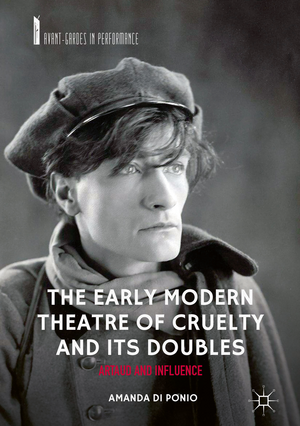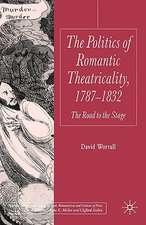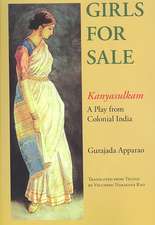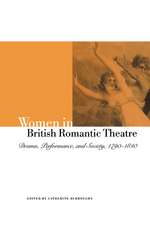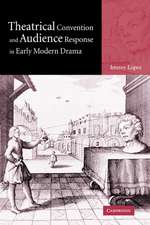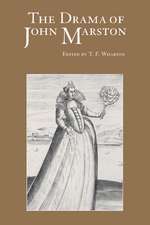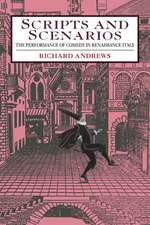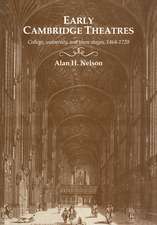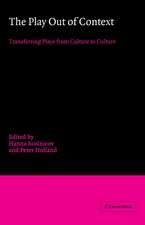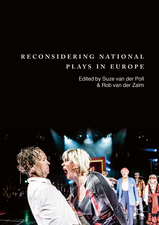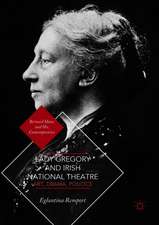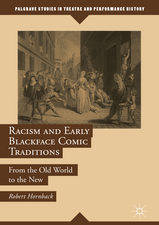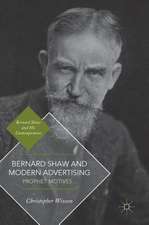The Early Modern Theatre of Cruelty and its Doubles: Artaud and Influence: Avant-Gardes in Performance
Autor Amanda Di Ponioen Limba Engleză Hardback – 10 sep 2018
This book examines the influence of the early modern period on Antonin Artaud’s seminal work The Theatre and Its Double, arguing that Elizabethan and Jacobean drama and their early modern context are an integral part of the Theatre of Cruelty and essential to its very understanding. The chapters draw links between the early modern theatrical obsession with plague and regeneration, and how it is mirrored in Artaud’s concept of cruelty in the theatre. As a discussion of the influence of Shakespeare and his contemporaries on Artaud, and the reciprocal influence of Artaud on contemporary interpretations of early modern drama, this book is an original addition to both the fields of early modern theatre studies and modern drama.
| Toate formatele și edițiile | Preț | Express |
|---|---|---|
| Paperback (1) | 389.32 lei 38-44 zile | |
| Springer International Publishing – 14 dec 2018 | 389.32 lei 38-44 zile | |
| Hardback (1) | 586.55 lei 6-8 săpt. | |
| Springer International Publishing – 10 sep 2018 | 586.55 lei 6-8 săpt. |
Preț: 586.55 lei
Preț vechi: 690.06 lei
-15% Nou
Puncte Express: 880
Preț estimativ în valută:
112.27€ • 121.99$ • 94.37£
112.27€ • 121.99$ • 94.37£
Carte tipărită la comandă
Livrare economică 21 aprilie-05 mai
Preluare comenzi: 021 569.72.76
Specificații
ISBN-13: 9783319922485
ISBN-10: 3319922483
Pagini: 320
Ilustrații: XII, 270 p.
Dimensiuni: 148 x 210 x 24 mm
Greutate: 0.49 kg
Ediția:1st ed. 2018
Editura: Springer International Publishing
Colecția Palgrave Macmillan
Seria Avant-Gardes in Performance
Locul publicării:Cham, Switzerland
ISBN-10: 3319922483
Pagini: 320
Ilustrații: XII, 270 p.
Dimensiuni: 148 x 210 x 24 mm
Greutate: 0.49 kg
Ediția:1st ed. 2018
Editura: Springer International Publishing
Colecția Palgrave Macmillan
Seria Avant-Gardes in Performance
Locul publicării:Cham, Switzerland
Cuprins
1. Introduction.- 2. Interpreting Antonin Artaud’s Theatre of Cruelty Foundations: Théâtre Alfred Jarry – Three Influential Events – Elizabethan Dramatic Conventions – Cruelty in the Theatre.- 3. Theatre and Plague: The Doubly Potent Spectacles of Early Modern Culture The Marseilles Plague – Physiological and Psychological Symptoms of Plague – Plague in Early Modern England – The Plague-Theatre – Filth and Infection – Theatre, Contagion, and Ritual.- 4. Bear-baiting and the Theatre of Cruelty The Pit and The Theatre – Elizabethan Receptivity – Jacobean Popularity – The Arena of Ambiguity – From Barbarity to Civility.- 5. Thyestean Savagery: Seneca, the Renaissance, and the Theatre of Cruelty Beyond Recitatio – The Sacrificial Crisis – Contagious Furor and Insatiability – Ritual and Bacchic Theatre – William Shakespeare’s Titus Andronicus directed by Yukio Ninagawa.- 6. Artaud and the ‘Elizabethans’: Revenge Tragedy as Inspiration for a Theatre of Cruelty An Emblematic Approach to Stage Language – Arden of Faversham Revisited – The True Theatre – The Revenger’s Tragedy – The White Devil and The Duchess of Malfi – ’Tis Pity She’s a Whore.- 7. Artaud’s Les Cenci From Innocence to Effluence – Les Destructeurs – The Theatre of Cruelty Test.- 8. After Artaud: Peter Brook and The Theatre of Cruelty Season Preparing for a Season of Cruelty – Marat/Sade: On Stage – Marat/Sade: On Screen – Theatre as Cure.- 9. Conclusion.
Notă biografică
Amanda Di Ponio is Assistant Professor of English and Cultural Studies at Huron University College in London, Ontario, Canada. She completed her doctoral studies at the University of St Andrews. Her areas of interest include drama and performance, early modern social history, and twentieth-century theory.
Textul de pe ultima copertă
This book examines the influence of the early modern period on Antonin Artaud’s seminal work The Theatre and Its Double, arguing that Elizabethan and Jacobean drama and their early modern context are an integral part of the Theatre of Cruelty and essential to its very understanding. The chapters draw links between the early modern theatrical obsession with plague and regeneration, and how it is mirrored in Artaud’s concept of cruelty in the theatre. As a discussion of the influence of Shakespeare and his contemporaries on Artaud, and the reciprocal influence of Artaud on contemporary interpretations of early modern drama, this book is an original addition to both the fields of early modern theatre studies and modern drama.
Caracteristici
Provides a comprehensive study of the cultural context that helped shape Artaud’s Theatre of Cruelty Looks at Artaud's central deployment of the plague as a contagious and dangerous force Examines theatre after Artaud, with the understanding that the early modern context is integral to successful iterations of his theatre
